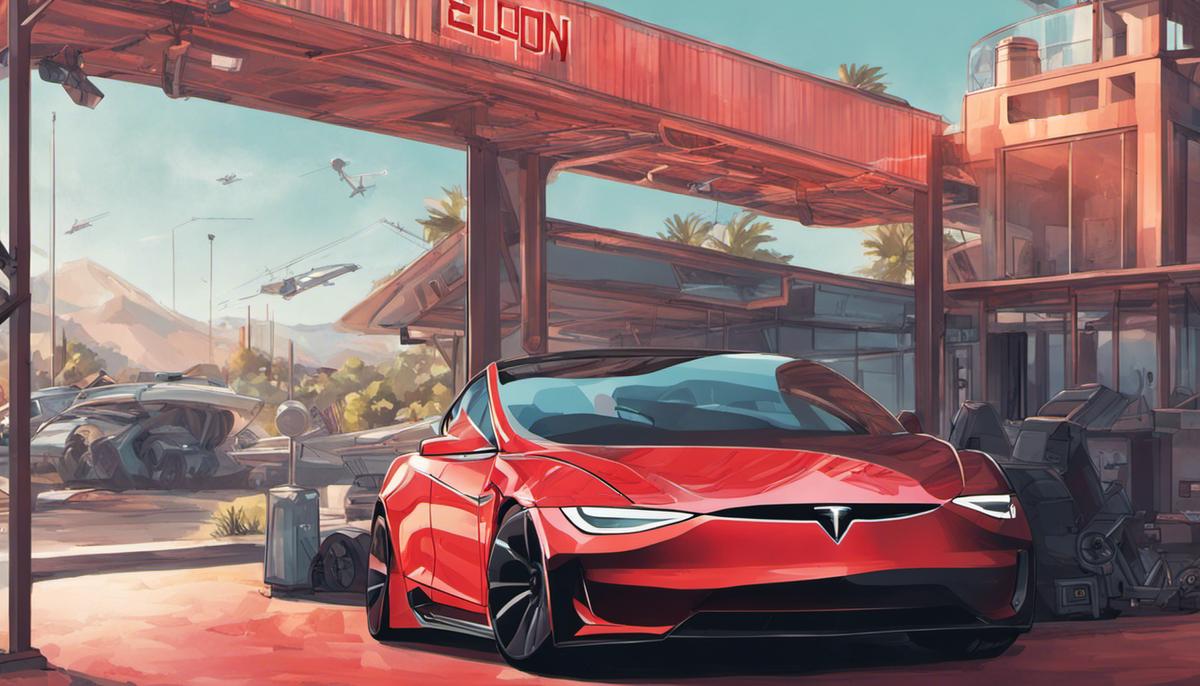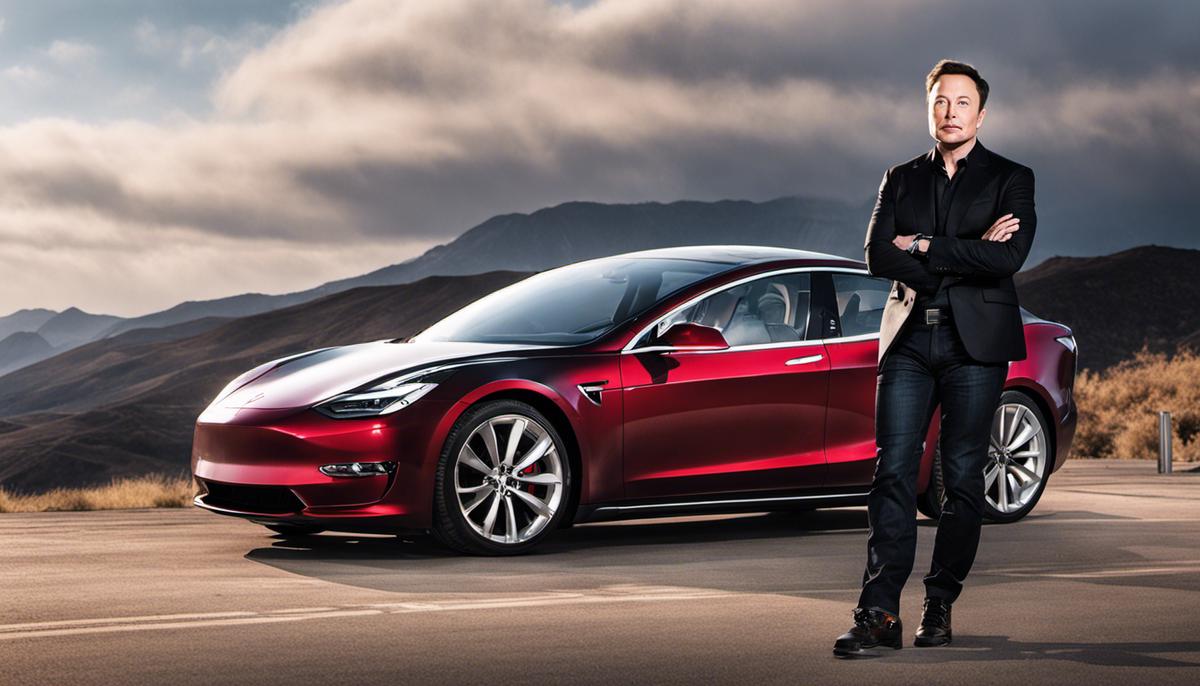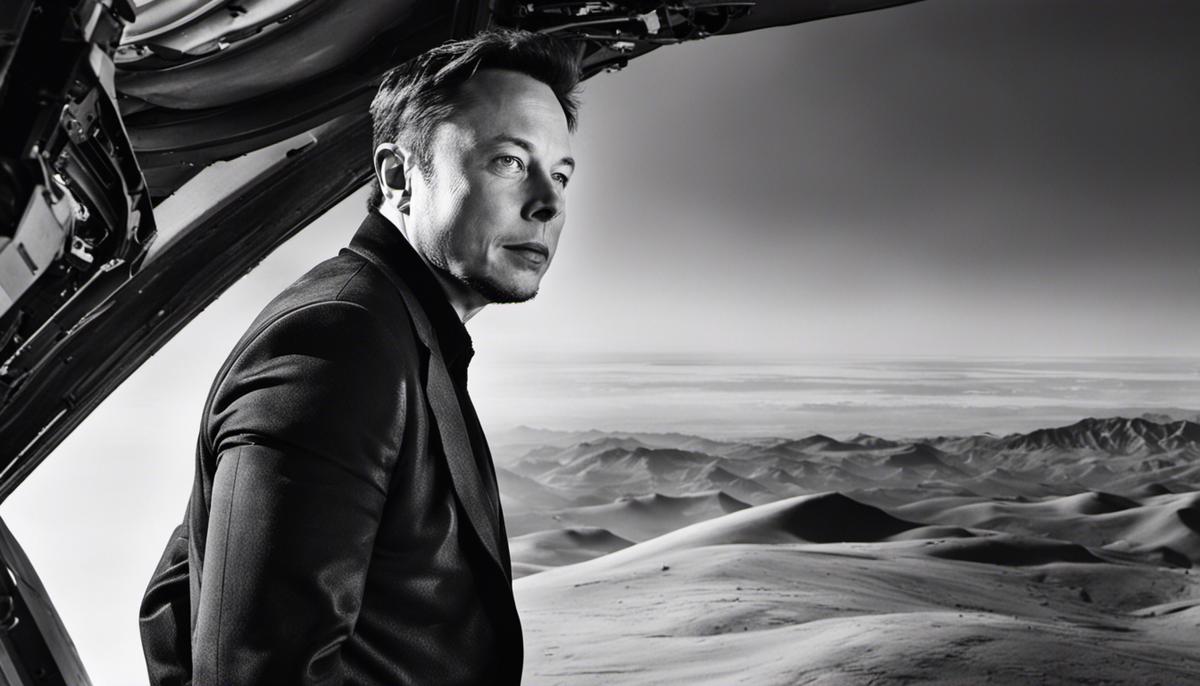In a world where timid conformism often prevails, Elon Musk’s brand of leadership stands as a beacon of daring ingenuity and indomitable resilience. This in-depth analysis delves into the distinct leadership qualities of one of the most transformative figures in recent history. From fostering an atmosphere of innovative thinking, to the unwavering persistency in the face of risky challenges, Musk’s expansive vision in tech industry is the driving force behind his groundbreaking advancements. The journey not only provides enormous insight into SpaceX’s and Tesla’s prolific leader, but also uncovers the kaleidoscopic nuances of his decision making processes, the triumphant breakthroughs and the challenges his unconventional style has brought about.
Innovative Thinking
Elon Musk and Innovative Thinking
Elon Musk is widely recognized as a pioneer in the tech industry with his steadfast innovative approach. Central to Musk’s leadership style is a strong proclivity towards innovative thinking, a quality that is crucial to his renowned status as a disruptor. This attitude is not just confined to conception; Musk prefers to take a hands-on approach, often immersing himself in the technical details of projects at his companies. This shared curiosity and insistence on radical innovation with his team offer unparalleled leadership and continuous technological evolution.
Fostering a Culture of Creativity
A crucial part of Musk’s approach to encouraging innovation in his companies is creating and fostering a culture of creativity. He achieves this by encouraging open communication, empowering his employees to come up with innovative ideas, and giving them substantial responsibilities in turning these ideas into reality. Elon Musk’s leadership model supports a creative environment where interdisciplinary knowledge is highly valued. If an employee from a different department has an innovative idea that can move any of his companies forward, they’re not just accepted but also encouraged and implemented.
A Mission-Driven Approach
One of the hallmarks of Musk’s approach to innovation is the bold, mission-driven aspirations he sets for his companies. SpaceX aims to colonize Mars, while Tesla is combating climate change by accelerating the transition to sustainable energy. These grand visions serve as a beacon, inspiring creativity and innovation among employees to achieve these goals. By pursuing these ambitious missions, Musk pushes boundaries, prompting critical thinking and innovative problem-solving skills among his workforce.
The First Principle Thinking
Musk’s innovative mindset is driven significantly by the “First Principles” thinking method he frequently utilizes. This approach involves breaking down a problem to its fundamental principles and then reasoning up from there, rather than relying on analogies or conventional wisdom. By employing this method, Musk challenges the status quo and fosters disruptive innovation – a type of innovation that significantly moves the needle.
Musks’s Approach to Failure
Musk’s approach to failure also serves as a driving force towards innovation. He sees failure not as a setback, but as an opportunity for learning and innovation. The knowledge gained from failure is invaluable in refining ideas and approaches. This mindset encourages a culture of risk-taking and experimentation seen in few other companies.
Elon Musk’s Innovation-Driven Leadership and Its Effects on the Tech Industry
Elon Musk is a remarkable figure in the tech industry due to his unique and innovation-driven leadership. Known to take significant risks and challenge long-standing norms, his leadership style has motivated aspiring entrepreneurs and existing companies alike. What sets Musk apart is not just his boldness in challenging industries dominated by entrenched entities, but how this audacious approach has incited a chain reaction, inspiring others to think and act innovatively. As a result, his impact has instigated a significant shift in the tech industry, pushing the limits of technology and innovation.

Risk-Taking and Persistence
The Role and Influence of Elon Musk’s High-Risk Tolerance
Elon Musk, serving as the CEO of both SpaceX and Tesla, is famously characterized by his high-risk tolerance. Unfazed by incurring massive gambles, Musk’s philosophy is one of staunch belief in reaping big rewards from taking considerable, well-considered risks. Illustrating this belief is his decision to inject his personal wealth into his companies at the times of their difficulties. Notably, in 2010, Musk invested his final $35 million into SpaceX and Tesla, a move perceived as exceedingly hazardous given the undefined state of space exploration and electric vehicle markets at the time.
Resilience Amidst Failures
Musk’s resilience in the face of failure is almost as legendary as his entrepreneurial success. Despite setbacks and obstacles that would discourage most, his determination and ability to bounce back from adversity are noteworthy. His unyielding resilience was particularly apparent in the early days of SpaceX, a time marked with many launch failures. Despite these daunting roadblocks, Musk remained steadfast, learned from these failures, and pushed his team forward, resulting in the eventual success of SpaceX.
Never-Give-Up Attitude
Musk’s robust, never-give-up attitude is another crucial component of his leadership style. He appears to genuinely believe in the missions and goals he sets for his companies and is willing to persist in the face of adversity to achieve them. This can be seen in his persistent efforts with both SpaceX and Tesla. For example, despite facing bankruptcy in 2008-2009 due to the global financial crisis, Musk refused to give up on Tesla. This persistent optimism proved beneficial as Tesla eventually turned a profit in 2020.
Lessons in Musk’s Approach to Risks and Resilience
Musk’s approach to risks and resilience offers many lessons for business leaders. His willingness to take big bets underscores the importance of being bold and ambitious in business. His resilience teaches leaders the value of learning from failures instead of being deterred by them. And his never-give-up attitude emphasizes the critical role of persistence and optimism in achieving long-term success. Each of these elements of Musk’s leadership style contributes to his extraordinary achievements in the tech industry.
Musk’s Ubuntu Leadership Approach
At the core of Musk’s approach is a distinctive leadership style, ingrained in his driven, ambitious, and dynamic personality. Known for his long hours and meticulous attention to technical decisions, Musk’s hands-on leadership has made its mark. Despite criticism at times for micromanagement, there’s no question that his unwavering dedication has been instrumental in the advancement of his ventures. This blend of courageous risk-taking, resilience, and hands-on leadership positions Elon Musk as a highly influential and unparalleled figure in the business arena.

Visionary Leadership
Transformative Vision: The Hallmark Of Musk’s Leadership
One of the key elements distinguishing Elon Musk from other global business leaders is his transformative vision. As the head of future-forward companies like SpaceX and Tesla, Inc., Musk’s leadership is not only about visualizing audacious goals but also converting those ambitions into innovative, path-breaking products and services.
Despite discussing seemingly distant or unattainable goals – like setting up a human colony on Mars or innovating speedy underground transport systems – Musk has displayed an unparalleled knack for making the inconceivable achievable, and in some instances, routine. In essence, Musk’s form of leadership epitomizes the sheer power of visionary prowess.
Motivating Workforce and Inspiring Communities
A key feature of Musk’s leadership style is his ability to motivate his workforce and to inspire wider communities through his ambitious projects. He paints credible pictures of the future and sets challenging goals, which can excite and inspire his employees to go beyond their perceived limitations. A top example of this is how Space X set the seemingly audacious goal of reducing space exploration costs to enable human life on Mars. Yet, the company now routinely launches and lands rockets, something that was once thought impossible.
Musk also creates the narrative that the employees are part of shaping the future. He involves them in his vision, making them feel like they are contributing to a grand, transformative plan. These factors create a high sense of job satisfaction, intense engagement, and substantial motivation amongst his staff.
Impact beyond Business
Elon Musk’s visionary leadership extends beyond his own companies and workforce, leaving a lasting impact on the societies they operate in. He sees his companies as much more than just profit-generating entities. Instead, they’re vehicles for addressing significant global issues such as climate change and dependence on fossil fuels.
For example, Tesla focuses on products like electric cars and renewable energy storage solutions. By doing this, Musk is not only creating a thriving company but also promoting a shift towards more sustainable modes of transport and energy use.
These socially conscious business practices reflect Musk’s vision of the future, enhancing his reputation as a leader who thinks far ahead of his time. They also increase the pride and dedication of his employees who know they’re contributing to a cause bigger than themselves, while inspiring action from other companies, industries, and communities.
Elon Musk: A Visionary Leader
A distinguishing characteristic of Elon Musk’s leadership is his unique approach to management, driven by his visionary mindset. Musk is known for setting aggressive deadlines, encouraging his team to reach seemingly impossible goals. While this can create stress and potentially lead to burnout, it also propels the team towards innovation and efficiency, often exceeding their expectations.
There is a potential downside to setting such high goals, too – these expectations can be a source of significant stress and can sometimes lead to burnout. However, many applaud Musk for his unwavering commitment to progress and his tireless dedication to his vision for the future.
Overall, Musk’s futuristic and visionary leadership sets him apart. It not only inspires his workforce but also influences wider communities. His leadership style focuses on setting goals and managing with a clear vision in mind, proving that although demanding, this form of leadership can produce remarkable outcomes.

The SpaceX and Tesla: Case Studies
Understanding the Leadership Style of Musk at SpaceX
Musk’s leadership approach at SpaceX exemplifies vision, resilience, and a high tolerance for risk. He created the concept of reusable rockets to reduce the financial burden of space travel – an idea initially met with widespread skepticism. Despite numerous setbacks, Musk’s persistence and focus on his vision have enabled SpaceX to achieve groundbreaking advancements such as the development and successful landing of reusable orbital rockets, the launch of the first privately funded spacecraft, Dragon, to dock with the ISS, and the creation of the Falcon Heavy, the world’s largest operational rocket.
When it comes to decision-making at SpaceX, Musk adopts a data-centric approach, and encourages open communication and brainstorming amongst his team. This has led to the cultivation of a culture rooted in first-principle thinking – a methodology that involves continuously questioning until reaching the most fundamental truth, empowering him to make informed decisions.
Musk is also lauded for maintaining a hands-on role in technical operations, often working in tandem with his engineers. This approach fosters a non-hierarchical workspace and encourages collaborative problem-solving.
Beyond conventional strategies, Musk is known for his showmanship approach to garnering attention and publicity for SpaceX. Notably, he launched a Tesla Roadster into space aboard the first flight of the Falcon Heavy rocket, a move that greatly bolstered public and media engagement.
Leadership Style at Tesla
At Tesla, Musk has displayed characteristics of transformational and transactional leadership styles. He consistently challenges the status quo, pushing the boundaries of what is considered possible in the automotive industry. He set a path for Tesla to become a leader in electric vehicles at a time when gasoline cars dominated the automobile market.
His decision-making technique at Tesla includes setting highly ambitious goals. Musk is known to set aspirational deadlines, a strategy that has attracted criticism given Tesla’s history of missing such goals. However, these high targets appear to drive his team to accomplish significant feats even when the actual deadline is missed.
Automating the production line at Tesla is another example of his revolutionary approach. Despite major hiccups in implementing full automation, Tesla has significantly advanced the use of robots in car production, leading to efficiency gains in the longer term.
Musk also actively utilizes social media for Tesla’s promotional activities, direct communication, and even corporate announcements. His tweets are known to impact Tesla’s stock performance, attract investors and retain public interest in the brand, demonstrating a radical shift from traditional corporate communication strategies.
Finally, Musk’s leadership at both SpaceX and Tesla is quite hands-on. He is known to work long hours, often sleeping at the factory or office, leading by example and inspiring his employees to push the boundaries of their potential.
Conclusion
Overall, Elon Musk’s distinct leadership style is a fusion of transformational, transactional, and participative leadership. He is recognized for setting audacious visions and lofty goals, fostering open dialogue, being heavily invested in technical intricacies, and using unconventional methods to maintain his companies’ spotlight. Despite the hurdles associated with this style, it has transpired groundbreaking achievements in SpaceX and Tesla, completely overhauling the space exploration and automotive sectors.

Criticism and Controversy
Controversial Management Style
Emblematic of Musk’s boundary-stretching leadership style is the innovative vision that he brings to the table, often revising traditional norms, which has sparked both criticism and admiration. His assertive and disruptive approach, while being heavily critiqued, has indisputably fostered substantial success for pivotal companies like SpaceX and Tesla.
Unconventional Leadership
Musk’s method of leadership is highly unorthodox and inconsistent with standard corporate models. He is known for his micro-managing approach and long working hours, leading some to criticize his leadership style as overly demanding. However, others praise his hands-on style noting its impacts in minimizing inefficiencies and getting the best output from his teams.
Criticisms and Challenges
Musk has been the centre of multiple controversies stemming from his tweets and public remarks. This sort of behavior has elicited criticism and concern from investors and global leaders alike, due to its potential effect on the companies he leads. This particularly became a critical issue in 2018 when a tweet about taking Tesla private resulted in an SEC investigation and subsequent fines.
Triumphs Despite Controversies
Despite these controversies, Musk has demonstrated resilience and adaptability, traits often considered key for successful leadership. He hasn’t let criticisms deter him from chasing his visions. Tesla has become one of the world’s most valuable companies, while SpaceX has achieved incredible feats in space exploration. This is in large part due to Musk’s relentless drive and tenacity in overcoming obstacles.
Innovative Risk-Taker
Musk’s propensity for taking major risks has earned him both criticism and praise. He has invested much of his own personal wealth into his companies, amidst skepticism from many quarters. While this approach has been severely criticized for putting investors’ funds at risk, it has also underpinned some of Musk’s key business successes, demonstrating his ability to embrace uncertainty and lead his companies to achieve ambitious goals.
Worker Treatment
Musk has been criticized for his alleged poor treatment of employees, including an extreme work culture and insensitivity to worker’s rights and demands. His companies have faced numerous lawsuits alleging discrimination and unfair labor practices. However, many point out Musk’s ability to attract and retain top talent as evidence of the appealing nature of his vision and leadership style, despite these issues.
Conclusion
Assessing Musk’s leadership involves balancing the positives of innovation, resilience, and risk-taking against the controversies and criticisms surrounding his actions and management style. His style does not conform to standard leadership models and his willingness to push boundaries often invites criticism. This unconventional style, rife with triumphs and challenges, is a large part of what makes Musk the leader he is, for better or for worse.

Ultimately, Elon Musk’s leadership transcends the norms, etching a profound indelible impact on human technological progression. His relentless appetite for innovation, dogged persistence in face of risks, and his far-sighted vision paint a charismatic portrait of leadership. Unpacking the labyrinthine intricacies of his leadership at SpaceX and Tesla provides key insights into his unique strategies and methods of driving success. His journey is, however, a convoluted confluence of accolades and criticisms, triumphs and controversies, illuminating a leadership style as multifaceted and complex as the man himself.
